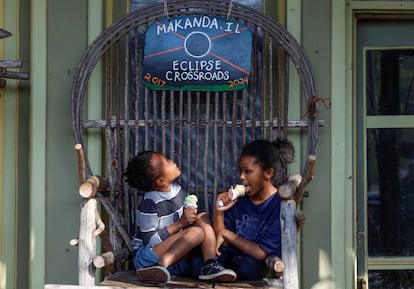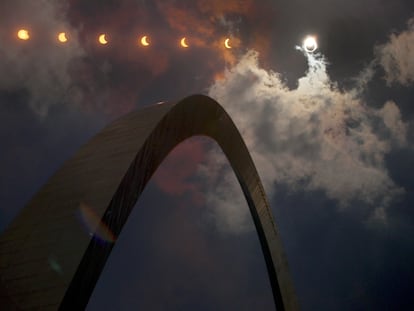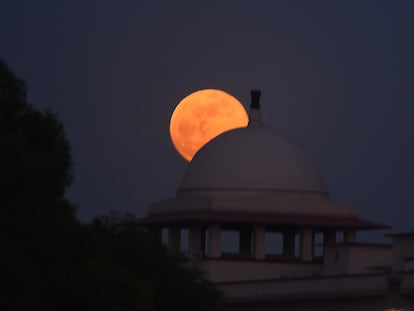Excitement over Monday’s total solar eclipse grips North America, from prison cells to cruises
Millions of people in search of experiences have traveled to spots along the path of the rare event, which will be visible from parts of Mexico, the US and Canada


A Baptist, a Muslim, a Seventh-Day Adventist, two Santeros and an atheist serving time at Woodbourne penitentiary in New York filed a lawsuit a few days ago against prison officials’ decision not to let them go outdoors to see Monday’s total solar eclipse. All the plaintiffs, including the atheist, claimed that they considered it a religious event and that keeping them indoors violated their rights. The group finally reached an agreement with prison officials and will be able to see the Moon come between the Sun and the Earth. The satellite’s shadow will travel across North America from south to north and from east to west, crossing Mexico, the United States and Canada along its path. Millions of citizens will look up at the sky today, and traffic jams and large crowds are expected at key viewing points as eclipse fever takes hold.
Even before taking place, the event has already left its mark. Hotel prices in the path of totality, the area where the Moon will completely block the Sun, have skyrocketed. Millions of tourists eager for experiences have traveled hundreds or even thousands of miles to witness the cosmic spectacle in its fullness.
Hotels are not the only ones that have detected a business opportunity. Airlines such as Southwest and Delta have announced special flight routes to view the eclipse; New York skyscrapers have hosted exclusive parties, and there are eclipse cruises to view it from the water. The event has inspired festivals, all kinds of merchandise ranging from solar glasses to T-shirts, and eclipse-themed menus at fast food chains and restaurants.
Krispy Kreme is selling the “total solar eclipse doughnut” in collaboration with Oreo, where the donut is the Sun and the cookie is the Moon that passes through it. Sonic has launched the Blackout Slush Float, Frito Lay has partnered with an astronaut, Kellie Gerardi, to offer a special limited edition of its SunChips brand. “SunChips invites fans to experience a cosmic collaboration in the sky and on their tastebuds with an exclusive, new flavor mash-up — SunChips Solar Eclipse Limited-Edition Pineapple Habanero and Black Bean Spicy Gouda.” It is not very clear what the astronaut’s responsibility is in all this, but Frito Lay has made it clear in its advertising that Gerardi “has literally gone to space.”
Some media outlets have been proposing songs for the event. Total eclipse of the heart, by Bonnie Tyler, easily leads the list, but there is no shortage of songs by Bruce Springsteen, Taylor Swift, Rosalía, and Pink Floyd on the suggested playlists.
Meanwhile, on the Canadian side of Niagara, in the province of Ontario, local authorities were bracing for a flood of visitors. The famous falls, on the border between the United States and Canada, lie in the path of the total eclipse. The city’s mayor, Jim Diodati, said a few weeks ago that he hopes that Monday will break visitor records in a place that already attracts mass tourism. Due to expected heavy traffic and other disruptions, hundreds of schools have decided to close or hold classes remotely in Texas, Indiana, Ohio, New York, Pennsylvania, and Vermont. The baseball game between the New York Yankees and the Miami Marlins has had to be delayed four hours due to the eclipse, so that the playing field does not darken shortly after it starts.
The last total eclipse that the United States experienced, in 2017, caused fuel shortages, lack of telephone coverage in certain areas and a collapse of services, including restaurants, in areas with a sudden massive influx of people. This time around, an even greater turnout is expected. The next total solar eclipse in the United States will not take place before 2033 and then it will be limited to Alaska. In 2044, the Moon’s shadow will darken western Canada, Montana and North Dakota. In 2045, a total solar eclipse will cross the country from California to Florida.
“It will be one of the biggest tourism events the state has ever seen,” says Michael Pakko, an economist at the University of Arkansas at Little Rock. “I can't imagine any other event that will have the same number of visitors as we will receive this weekend in Arkansas. We expect many visitors to come to our region, and visitors tend to spend money, so we hope it will have a significant economic impact,” he explains in an email message.
The path of the total eclipse will first be visible from land in Mazatlán (Mexico), on the Pacific coast, at 11:07 local time. After going over Durango, Torreón and Monclova, it will cross into the United States through the Eagle Pass border crossing at 1:27 p.m. local time. In Texas it will also cover San Antonio, Austin and Dallas after noon. On its way north, it will darken Little Rock (Arkansas), Indianapolis (Indiana), Cleveland (Ohio) and Buffalo (New York). On the border with Canada it will completely cover Niagara Falls, skim Toronto and completely block the Sun in parts of Montreal before heading to the North Atlantic through Newfoundland.
Approximately 44 million people live along the route where the eclipse will be total, and another 200 million in a wider strip where the darkness will be significant, which suggests that it will be the most viewed eclipse on the continent in history. It will be noticeable to a greater or lesser extent in much of North America, including 85% to 90% in large Eastern cities such as New York, Boston, or Washington.
The total eclipse will last longer than usual because the Moon will be only 360,000 kilometers from Earth, one of the closest approaches between the two in the year, which will cause an especially long and intense period of darkness when they align. The total eclipse will have its longest duration when it passes through Mexico: 4 minutes and 28 seconds. In other places, such as New York state, it will last just a minute and a half. Scientists will take the opportunity to perform various experiments.
If the sky is clear, a comet and four planets will be visible during the total eclipse. Jupiter will be to the left of the Sun and Venus to the right. Saturn and Mars will be to the right of Venus, but fainter. Even comet 12P/Pons-Brooks, which is passing in front of the Earth as it does every 71 years, will be visible near Jupiter, although in the latter case a telescope will most likely be needed. Above all, what is needed is clear skies, but unfortunately for eclipse-gazers, clouds are expected along large areas of the route.
A frog that swallows the Sun
Cultural accounts of the solar eclipse in Native American cultures vary widely, according to Erin Fehr, deputy director and archivist at the National Sequoyah Research Center at the University of Arkansas in Little Rock. Fehr explained the interaction between mythology and science in ancient American cultures at an event at the Arkansas Museum of Fine Arts. "The Navajo consider the solar eclipse a sacred time of silence and meditation. They stay home and do not eat, drink or sleep. They reflect on their lives. When the eclipse ends, it is considered a time of rebirth and renewal. Some consider the solar eclipse as a new year and make resolutions. Although it is a sacred moment and one should not look at the Sun, some do. It depends on each family," he explains.
The Cherokee have a story that tells of a giant frog that swallows the Sun. "When the frog swallows the Sun, everything becomes dark. The Cherokee have to manage to get the frog to spit out the Sun. The men take rifles and pistols, shoot in the air and beat drums. The women take shell shakers and bang pots and pans. They make a lot of noise to scare the frog into spitting out the Sun. It ends with a celebration of the return of the Sun," he explains.
"I think it's interesting to learn how different cultures view a given event," says Fehr. "A total solar eclipse is a phenomenon that can be seen once in a lifetime. It is a great opportunity."
Sign up for our weekly newsletter to get more English-language news coverage from EL PAÍS USA Edition
Tu suscripción se está usando en otro dispositivo
¿Quieres añadir otro usuario a tu suscripción?
Si continúas leyendo en este dispositivo, no se podrá leer en el otro.
FlechaTu suscripción se está usando en otro dispositivo y solo puedes acceder a EL PAÍS desde un dispositivo a la vez.
Si quieres compartir tu cuenta, cambia tu suscripción a la modalidad Premium, así podrás añadir otro usuario. Cada uno accederá con su propia cuenta de email, lo que os permitirá personalizar vuestra experiencia en EL PAÍS.
¿Tienes una suscripción de empresa? Accede aquí para contratar más cuentas.
En el caso de no saber quién está usando tu cuenta, te recomendamos cambiar tu contraseña aquí.
Si decides continuar compartiendo tu cuenta, este mensaje se mostrará en tu dispositivo y en el de la otra persona que está usando tu cuenta de forma indefinida, afectando a tu experiencia de lectura. Puedes consultar aquí los términos y condiciones de la suscripción digital.
More information
Archived In
Últimas noticias
Most viewed
- Reinhard Genzel, Nobel laureate in physics: ‘One-minute videos will never give you the truth’
- Pablo Escobar’s hippos: A serious environmental problem, 40 years on
- Charles Dubouloz, mountaineering star, retires at 36 with a farewell tour inspired by Walter Bonatti
- Why we lost the habit of sleeping in two segments and how that changed our sense of time
- The fall of a prolific science journal exposes the billion-dollar profits of scientific publishing










































